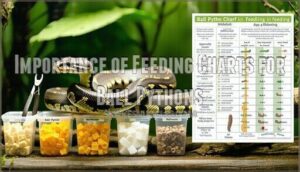This site is supported by our readers. We may earn a commission, at no cost to you, if you purchase through links.

These snakes typically eat one appropriately-sized rodent every 1-2 weeks, with frozen mice or rats costing $2-4 each.
Adult ball pythons require larger prey than juveniles, so your costs increase as your snake grows.
The cost to feed ball pythons also depends on where you source food – buying in bulk from reptile suppliers costs less than pet stores.
Factor in your snake’s eating habits too, since ball pythons can be finicky eaters who sometimes refuse meals for weeks, and understanding feeding schedules and portion sizes helps you budget effectively while keeping your scaly friend healthy and ensuring you can provide the right food at the right time, which is crucial for their overall well-being.
Table Of Contents
- Key Takeaways
- Monthly Costs of Owning a Ball Python
- Snake Food Monthly Cost Breakdown
- Feeding Requirements for a 2-Foot Ball Python
- Tank Size for Full-Grown Ball Pythons
- Cost Breakdown of Feeding a Ball Python
- Feeding Frequency for Ball Pythons
- Importance of Feeding Charts for Ball Pythons
- Nutritional Needs for Ball Pythons
- Pet Snake Initial Investment Cost Factors
- Ensuring Proper Feeding for Ball Pythons
- Frequently Asked Questions (FAQs)
- How much is a vet bill for a ball python?
- How much should a ball python be fed?
- Is a ball python high maintenance?
- How often do ball pythons go to the vet?
- How much does it cost to own a ball python monthly?
- How much does snake food cost per month?
- How much should a 2 foot ball python eat?
- How much does it cost to feed a ball python?
- How often do ball pythons eat?
- Do ball pythons need feeding charts?
- Conclusion
Key Takeaways
- You’ll spend $8-12 monthly or $100-150 annually feeding your ball python, making them surprisingly affordable pets despite their reputation for being finicky eaters.
- Your costs depend on your snake’s age and size – juveniles need cheaper mice weekly ($4-8/month) while adults require larger, pricier rats every 2 weeks ($8-30/month).
- You can significantly reduce feeding expenses by buying frozen rodents in bulk from reptile suppliers rather than purchasing individual prey items from pet stores.
- Factor in your ball python’s unpredictable eating habits when budgeting, as these snakes commonly refuse meals for weeks at a time, which can actually help stretch your food costs.
Monthly Costs of Owning a Ball Python
When you’re considering a ball python as your scaly companion, the monthly expenses for feeding typically range from $10 to $20.
Budget-friendly ball pythons need just $10-20 monthly for proper nutrition.
Your ball python food cost centers around rodents—primarily mice and rats—which form their essential diet. Young pythons need more frequent meals than adults, affecting your reptile food budget substantially.
Beyond basic python feeding expenses, factor in Enclosure Maintenance like substrate changes and cleaning supplies. Healthcare Costs for routine vet checkups and Unexpected Expenses for emergencies can impact your budget.
Your Owner Lifestyle and commitment to Long-Term Budgeting guarantee your snake receives proper nutrition consistently.
Most owners find the snake diet price manageable when planned properly, making ball pythons accessible pets for dedicated reptile enthusiasts.
Snake Food Monthly Cost Breakdown
Looking at your ball python food cost needs, here’s what you can expect monthly:
- Frozen vs. Live rodents – Frozen prey costs 20-30% less than live options, saving you money while providing equal nutrition.
- Prey Size Impact on budget – Young pythons eat $1-2 pinkie mice weekly ($4-8 monthly), while adults need $4-5 large mice or $10-15 rats biweekly ($8-30 monthly).
- Bulk Buying Savings – Purchasing frozen rodents in bulk reduces your reptile food budget substantially compared to single purchases.
- Dietary Supplement Costs – Most python feeding expenses don’t require supplements, but occasional calcium dusting adds minimal monthly expenses to your snake food cost.
Feeding Requirements for a 2-Foot Ball Python
A 2-foot ball python represents the juvenile stage, requiring weekly feeding to support rapid growth.
Young pythons grow fast—weekly meals fuel their rapid development into healthy adults.
Your ball python diet should focus on appropriately sized frozen mice or rat pups – prey size must match your snake’s widest body diameter to prevent regurgitation. Frozen vs live prey favors frozen for safety and convenience, with rodent variety including fuzzy rats or adult mice.
To guarantee proper nutrition, consider the prey’s weight and aim for appropriate prey size relative to the snake’s body mass.
Your feeding schedule should occur every 5-7 days during nighttime hours using tongs. Supplement needs are minimal since balanced diets provide complete nutrition, keeping your ball python feeding guide simple and cost-effective.
Tank Size for Full-Grown Ball Pythons
Your full-grown ball python needs proper Enclosure Dimensions to thrive. Adult ball pythons require minimum Space Requirements of 48"L × 24"W × 24"H, allowing your snake to stretch completely.
A 5-foot snake needs at least 5 feet of length for ideal Snake Wellbeing.
Size Progression matters: hatchlings start in 10-gallon tanks, juveniles move to 20-gallon setups, while adults need 55-75 gallon enclosures. Females typically require larger spaces than males.
A suitable enclosure should also help maintain proper humidity levels. Habitat Enrichment includes multiple hides at warm and cool ends, climbing branches, and substrate depth of 2-4 inches.
Proper tank size directly impacts your ball python’s health, preventing stress and obesity while supporting natural behaviors like exploration and climbing.
Cost Breakdown of Feeding a Ball Python
Understanding your snake’s cost of owning python requires examining prey type and sourcing strategies.
Frozen vs. live options affect your budget substantially—frozen mice cost $1-5 per unit while live prey runs higher.
To find affordable options, explore current frozen mice prices.
Bulk discounts from online suppliers reduce monthly expenses from $15 to $8-12.
Breeding rodents cuts costs dramatically but requires initial investment.
Consider supplement costs minimal since whole prey provides complete nutrition.
Smart shopping keeps your python food guide budget-friendly while ensuring proper reptile food prices don’t break the bank.
Feeding Frequency for Ball Pythons
Feeding frequency varies by age, making it your snake’s growth stage roadmap. Hatchlings need meals every 5-7 days, while adults thrive on bi-weekly or monthly schedules.
Adjust based on weight and body condition to prevent overfeeding signs.
- Juvenile frequency: Feed young ball pythons (under 200g) weekly for proper growth
- Adult schedules: Mature snakes eat every 2-3 weeks, matching natural patterns
- Breeding needs: Gravid females require weekly large rats during reproductive cycles
- Adjusting frequency: Monitor body condition and reduce meals as snakes age
Importance of Feeding Charts for Ball Pythons
Charts become your roadmap for successful ball python care, guiding every feeding decision with precision. They standardize feeding schedules, prevent overfeeding, and support growth tracking through consistent portion control.
Proper python feeding tips include monitoring weight changes and feeding responses to detect health issues early.
| Chart Benefits | Key Features |
|---|---|
| Growth tracking & portion control | Age-specific feeding intervals |
| Health monitoring & prey selection | Weight-based serving sizes |
| Consistent feeding schedules | Documentation for veterinary care |
Snake feeding charts eliminate guesswork by providing structured guidelines for ball python care. They help you avoid obesity through controlled portions while ensuring proper prey selection based on your snake’s size and age.
Consider using a ball python chart to assist with correct feeding practices. Maintaining detailed feeding records supports early detection of health problems and creates valuable documentation for veterinary consultations when needed.
Nutritional Needs for Ball Pythons
Maintaining proper reptile nutrition for your ball python isn’t rocket science, but it does require attention to detail.
These obligate carnivores need whole prey to thrive, as fragmented meals lack essential nutrients found in bones, organs, and gut contents.
Your snake’s nutritional needs center around these key factors:
- Prey Variety: Rotate between rats, mice, and occasional chicks to mimic their wild diet
- Prey Size: Choose items no larger than 1.5x your snake’s widest girth
- Prey Types: Prioritize rats over mice for superior protein-fat ratios
- Raw Feeding: Whole prey eliminates the supplementation debate entirely
Wild diet research shows ball pythons consume 70% rodents and 25% birds naturally.
African Soft Fur rats offer high protein and low fat content, making them a desirable choice.
While some keepers explore raw feeding trends, frozen-thawed prey remains the safest option.
Nutritional supplements aren’t typically necessary when feeding whole prey, though occasional calcium dusting won’t hurt.
Remember, proper prey sizing prevents regurgitation and guarantees your snake gets complete nutrition from each meal.
Pet Snake Initial Investment Cost Factors
When you’re considering buying a ball python, the upfront costs extend far beyond the snake itself.
You’ll need to budget for the complete setup including enclosure, heating, lighting, and accessories, which can range from several hundred to over a thousand dollars depending on your choices.
Snake Prices
When you’re shopping for a ball python, snake prices can catch you off guard if you’re not prepared. Common morphs like Yellow Belly and Enchi typically cost $65 to $75, making them budget-friendly entry points for new owners.
However, morph values climb quickly as genetics impact becomes more pronounced. Rare morphs command premium prices—Ivory and Pied morphs range from $245 to $405, while ultra-rare Black Eyed Leucistic specimens fetch $445 to $455.
Breeder reputation also influences pricing, as established breeders often charge more for quality genetics and health guarantees. One should also consider that rare snake morphs can exceed $5,000.
Your initial cost investment depends heavily on these genetic factors. Females cost slightly more than males, with breeding-age females commanding the highest prices due to their reproductive potential.
Remember, while these snake prices represent your upfront investment, they’re separate from ongoing feeding costs, prey types, and prey size considerations that’ll impact your long-term budget for cost to feed snakes.
Additional Costs
Beyond the snake itself, you’ll face several additional costs that can quickly add up. Vet expenses represent one of your biggest ongoing investments, with routine checkups running $50-100 and emergency visits potentially reaching hundreds more.
Building an emergency fund for unexpected costs like respiratory infections or feeding strikes will save you stress later. Enclosure upgrades become necessary as your python grows, and supplement costs for calcium dusting add to your monthly feeding costs.
Here’s what you’re looking at:
- Initial setup expenses: Thermostats, heating elements, and quality hides can cost $200-400
- Ongoing maintenance: Substrate replacement, electricity for heating, and cleaning supplies
Your python diet cost extends beyond just rodents when you factor in these extras. Smart owners budget an additional $30-50 monthly for these additional costs on top of basic cost to feed snakes. This cost breakdown might seem overwhelming initially, but proper planning prevents financial surprises down the road.
Ensuring Proper Feeding for Ball Pythons
Proper feeding ball pythons starts with understanding their unique needs. Prey size should match your snake’s thickest body section, creating a slight bulge when swallowed. Feeding frequency varies by age: juveniles eat every 5-7 days, while adults thrive on 10-14 day schedules.
Food variety isn’t essential since python diet cost stays manageable with consistent mice or rats. Most ball pythons don’t require supplement needs when fed whole prey. Raw feeding trends exist, but frozen rodents remain safer and more convenient.
Consistent feeding schedules reduce stress and feeding strikes. Watch for proper digestion between meals, and adjust snake feeding timing based on your python’s response. Remember, a relaxed snake feeds better than a stressed one.
Frequently Asked Questions (FAQs)
How much is a vet bill for a ball python?
Back when snake doctors wore stethoscopes made of wood, veterinary bills seemed simpler.
You’ll typically pay $50 to $200 per visit for your ball python’s checkup, depending on services needed and your location.
How much should a ball python be fed?
You’ll feed your ball python based on its age and size. Juveniles eat every 5-10 days, while adults eat every 10-14 days. Prey should match your snake’s girth width.
Is a ball python high maintenance?
Ball pythons aren’t high-maintenance pets.
You’ll handle feeding every 1-2 weeks, maintain proper temperatures (75-92°F), and guarantee adequate humidity.
They’re actually quite forgiving compared to many reptiles, making them beginner-friendly snakes.
How often do ball pythons go to the vet?
You’ll typically take your ball python to the vet annually for routine check-ups, plus additional visits if health issues arise.
Healthy adult snakes don’t need frequent veterinary care like other pets, and this is a complete concept that highlights their relatively low maintenance as pets.
How much does it cost to own a ball python monthly?
You’ll spend about $15-30 monthly on your ball python, with feeding costs around $6-20 and occasional supplies like substrate or heating adjustments adding extra expenses as needed.
How much does snake food cost per month?
You’ll spend roughly $10-20 monthly on rodents for your ball python. Young snakes need smaller, cheaper prey weekly, while adults require larger, pricier meals every two weeks.
How much should a 2 foot ball python eat?
Your 2-foot ball python should eat one appropriately-sized mouse every 7-10 days. Choose prey that’s roughly the same width as your snake’s thickest part, creating a slight bulge when swallowed.
How much does it cost to feed a ball python?
You’ll spend about $10-$20 monthly feeding your ball python. Annual costs range from $100-$180, depending on your snake’s size and whether you choose frozen or live prey options.
How often do ball pythons eat?
Young ball pythons eat every 5-10 days, while adults feed every 10-14 days.
Mature pythons can go 2-3 weeks between meals.
You’ll adjust frequency based on your snake’s age and size.
Do ball pythons need feeding charts?
Like a compass guides explorers, feeding charts help you navigate your ball python’s nutritional journey.
You don’t absolutely need formal charts, but they’re incredibly helpful for tracking feeding schedules and prey sizes as your snake grows and matures.
Conclusion
Congratulations, you’ve just joined the exclusive club of people who budget for feeding a creature that might ignore food for weeks just to keep you guessing.
The cost to feed ball pythons averages $8-12 monthly, making these finicky eaters surprisingly affordable pets.
With proper planning around their unpredictable appetites and growth needs, you’ll maintain a healthy snake without breaking the bank.
Smart shopping and understanding feeding schedules guarantee your python thrives while your wallet stays happy.
- https://www.webmd.com/pets/feeding-a-ball-python
- https://www.reddit.com/r/ballpython/comments/sx2sdr/cost_estimate_for_ball_python_husbandry/
- https://a-z-animals.com/blog/ball-python-prices-purchase-cost-supplies-food-and-more/
- https://www.morereptiles.com/ball-python-feeding/
- https://www.everythingreptiles.com/ball-python-feeding/













